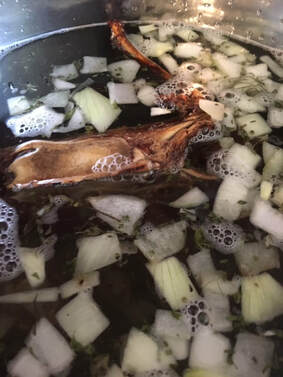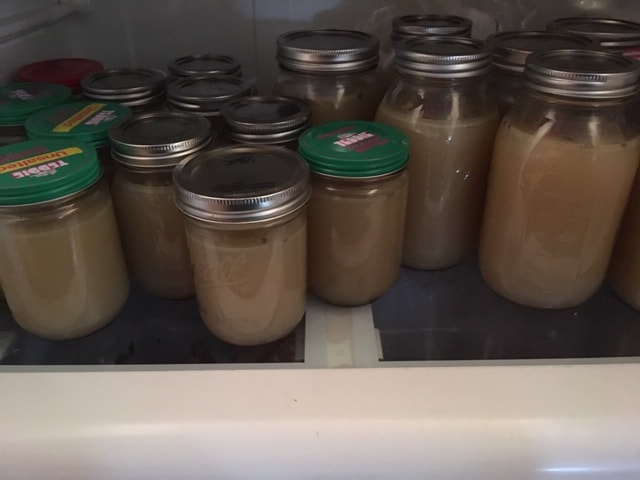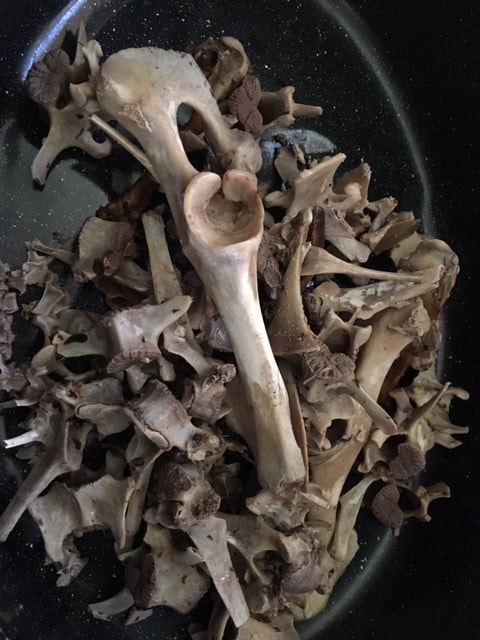
Today we are making bone broth here at Odin's Acres, a task we do fairly regularly and have
done so for years! We love all of the ways it can be used, and sometimes we just drink it by the
mug.
“Bone Broth” has become very popular in recent years, but as many of you know, it’s nothing
new. Many of our parents, grandparents and great grandparents would simmer bones on the
stove and keep the liquid as soup stock. The broth's more recent popularity is largely due to
excitement over collagen, and the huge amount of collagen in properly made bone broth.
Consuming collagen has been touted to rebuild the intestinal lining and maybe even lessen
wrinkles and cellulite as well as shorten general healing time with the promotion of cellular
renewal.
Does it work? Honestly I have no idea but I do believe that bone broth allows you to access lots
of important vitamins and minerals that have been locked away inside of the bones themselves.
When I was first diagnosed with thyroid disease I drank at least a pint of bone broth every day,
in hopes of improving my gut health and improving rates of vitamins, mineral and medication
absorption. I still try to consume some broth every week, and lucky for me we have the bones to
make enough for that.
Some of my favorite tips for making bone broth include: blanching and roasting the bones,
simmering for a very long time while adding minimal ingredients.
Blanching: Blanch your saved bones by simmering for about 20 minutes and scooping off the
accumulated foam, this helps get rid of any funky or off flavors that might be in the final product.
Roasting: roast the blanched bones at 450 degrees until the are a nice golden brown to bring
out their flavor
Simmer: at least 8 hours, lately I’ve been simmering closer to 24 hours to pull out as many
nutrients as possible
Few Ingredients: when making a large amount of broth it helps to make it versatile by only
adding a few vegetables and spices for flavor. I personally like to add onions, garlic, parsnips,
carrots and celery but you definitely don’t need that many different vegetables. I also add a few
dried herbs, some salt and a tiny bit of apple cider vinegar. The vinegar is supposed to help
make the nutrients in the bones more accessible.
For today’s batch I added goat bones, duck bones, and rabbit bones plus onions, garlic,
marjoram, dill, parsley, salt and a tiny bit of apple cider vinegar.
After about 24 hours I strain the broth and put it in jars to cool and freeze. Here on the
homestead we dry the bones and grind them into bone meal for the garden, where they help
grow more ingredients for the next round of broth!
done so for years! We love all of the ways it can be used, and sometimes we just drink it by the
mug.
“Bone Broth” has become very popular in recent years, but as many of you know, it’s nothing
new. Many of our parents, grandparents and great grandparents would simmer bones on the
stove and keep the liquid as soup stock. The broth's more recent popularity is largely due to
excitement over collagen, and the huge amount of collagen in properly made bone broth.
Consuming collagen has been touted to rebuild the intestinal lining and maybe even lessen
wrinkles and cellulite as well as shorten general healing time with the promotion of cellular
renewal.
Does it work? Honestly I have no idea but I do believe that bone broth allows you to access lots
of important vitamins and minerals that have been locked away inside of the bones themselves.
When I was first diagnosed with thyroid disease I drank at least a pint of bone broth every day,
in hopes of improving my gut health and improving rates of vitamins, mineral and medication
absorption. I still try to consume some broth every week, and lucky for me we have the bones to
make enough for that.
Some of my favorite tips for making bone broth include: blanching and roasting the bones,
simmering for a very long time while adding minimal ingredients.
Blanching: Blanch your saved bones by simmering for about 20 minutes and scooping off the
accumulated foam, this helps get rid of any funky or off flavors that might be in the final product.
Roasting: roast the blanched bones at 450 degrees until the are a nice golden brown to bring
out their flavor
Simmer: at least 8 hours, lately I’ve been simmering closer to 24 hours to pull out as many
nutrients as possible
Few Ingredients: when making a large amount of broth it helps to make it versatile by only
adding a few vegetables and spices for flavor. I personally like to add onions, garlic, parsnips,
carrots and celery but you definitely don’t need that many different vegetables. I also add a few
dried herbs, some salt and a tiny bit of apple cider vinegar. The vinegar is supposed to help
make the nutrients in the bones more accessible.
For today’s batch I added goat bones, duck bones, and rabbit bones plus onions, garlic,
marjoram, dill, parsley, salt and a tiny bit of apple cider vinegar.
After about 24 hours I strain the broth and put it in jars to cool and freeze. Here on the
homestead we dry the bones and grind them into bone meal for the garden, where they help
grow more ingredients for the next round of broth!


 RSS Feed
RSS Feed
